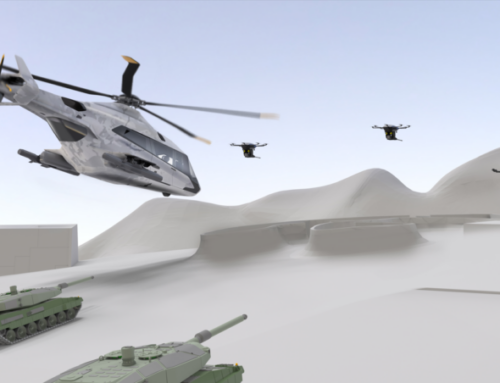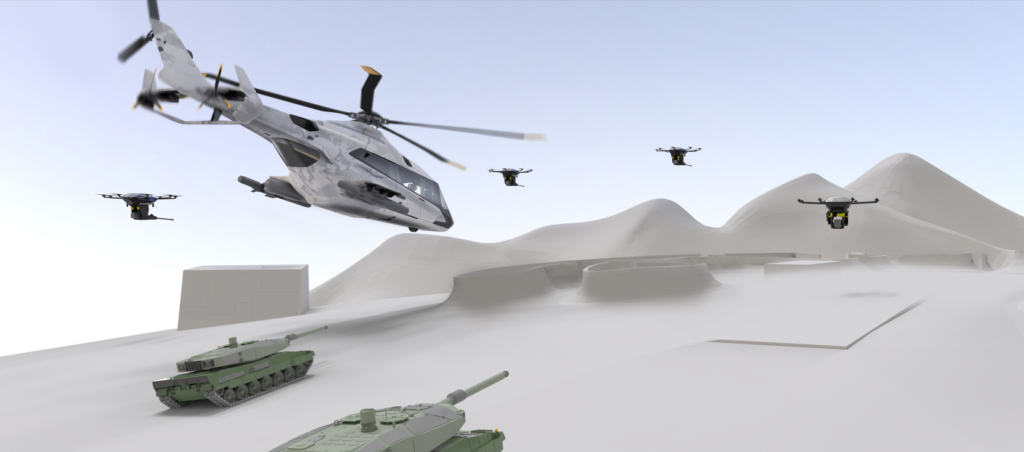This photo taken on April 14, 2024 shows flares from explosions in the sky over Jerusalem as Israel’s Iron Dome anti-missile system intercepts missiles and drones from Iran. (Photo by Jamal Awad/Xinhua via Getty Images)
WASHINGTON — Instead of congratulating themselves over the allied defeat of Iran’s 300-plus drones and missiles on Saturday, top Pentagon officials said they saw the barrage launched against Israel as a mere preview of the much larger salvos China could launch at Guam, Taiwan, and other targets in a future Pacific war.
There is some good news to celebrate, said Pentagon tech chief Heidi Shyu, the under secretary for research, development, and engineering. The ship-borne Aegis air defense system successfully shot down ballistic missiles aimed at Israel, she said, while the land-based Patriot “has proven itself in Ukraine.”
But the lesson learned from those two conflicts is not one of complacency, Shyu warned. Instead, she and other officials said at an NDIA missile defense conference Tuesday that the sheer scale of the future threat will require more and cheaper interceptors, new defenses such as high-powered lasers, and preemptive or retaliatory strikes on enemy launchers.
“Just look what happened over the weekend,” Shyu told the conference. “In a highly contested fight over the Indo-Pacific, that could be even greater numbers.”
It’s crucial to learn from Iran attack on Israel and Russia’s on Ukraine, said assistant secretary of defense John Plumb, and the most important lesson is that an enemy can launch a lot of missiles and drones at once. “The scale thing just hits me over and over and over” in both conflicts, he told the conference. “We have to have defense at scale, because the adversary can develop cheap systems at scale and then send them simultaneously.”
“We’ve got to be prepared for a level of capability and capacity we haven’t seen,” agreed the director of the Missile Defense Agency, Air Force Lt. Gen. Heath Collins. “As we’ve seen in Israel [and] in Ukraine… it is getting worse.”
“The sheer number of missiles that are out there today and that we’re seeing utilized in some of the more minor engagements is mind-boggling,” he said. “We’ve got to be prepared for major engagements.”
Even adversaries without professional militaries, like the Houthi irregulars in Yemen, are able to procure significant numbers of missiles and drones, Collins told the conference. And while MDA has historically focused on intercepting intercontinental ballistic missiles — which follow a predictable but blisteringly fast arc through outer space en route to their targets — the US and its allies now need to prepare for coordinated barrages of slower, lower, but more unpredictable cruise missiles, hypersonics, and drones.
Instead of just preparing to hit “fastballs,” he said, “now we’re hitting sliders and curveballs.”
Even traditional ballistic boosters are increasingly tipped with warheads that are capable of last-minute maneuvers to baffle defenders, added Plumb: “The value of maneuvering [reentry] vehicles is widely understood. … Very few missiles are truly ‘ballistic’ anymore.”
Yet even as the threat is becoming more maneuverable and evasive, it’s also becoming cheaper, thanks particularly to the proliferation of “one-way attack drones.” The supersonic THAAD, Patriot, and Standard Missile interceptors developed to shoot down ballistic weapons are expensive overkill against drones that can cost a few thousand dollars. Militaries can absorb the cost if they’re only shooting down a handful of incoming threats, Plumb argued, but not if you’re dealing with mass attacks like Iran’s 300-strong wave or worse.
No less a figure than the chairman of the Joint Chiefs of Staff, Air Force Gen. C.Q. Brown, emphasized the importance of expanding defenses against low-end drones. “I realize that the Missile Defense Agency tends to look at high end capabilities, but I really believe you’ve got to think about how we defend against all of these [threats],” he said in his remarks, which closed the conference. “This past weekend was a perfect example [of] the expansive use of drones.”
RELATED: Navy is down $1B in munitions from ops in Red Sea, says SECNAV
‘Go Against The Archer’
That cost imbalance between defense and offense has driven militaries around the world to look at less expensive options, from lasers and high-powered microwaves to old-fashioned bullets.
In Ukraine, Plumb said, “these guys have literally shot down cruise missiles” with .50 caliber machineguns. That requires a sophisticated but relatively inexpensive network of sensors, deployed as far forward as possible to pick up the incoming threat and rapidly alert mobile air defense guns in its path, he noted. Only if incoming missiles and drones bypass the first, affordable line of defense and threaten critical targets does Ukraine employ its limited supply of Patriots and other high-end Western interceptors, he said.
By contrast, Plumb continued, the US version of “layered” missile defense often fires the most expensive weapon first, because it has the longest range, while low-cost-per-shot alternatives like lasers or guns are so short-ranged they only come into play for close-in, last-ditch defense.
“You want your first layer to be pickets and the pickets have the cheaper shots, then save your most exquisite interceptors at the highest cost for leakers” that get through, Plumb said. “We roughly have that backwards. … Our most expensive interceptors usually have longer reach [and] our cheapest shots at at the end.”
Can the Pentagon procurement system and the defense industrial base turn that around? “Focusing on cost may be a new thing for this audience,” Plumb said drily. “We build very exquisite systems that work very well… Can we figure out a way to introduce much lower-cost interceptors to deal with the scale of the threat?”
One way to improve cost-effectiveness, Plumb emphasized, is to go on the offense and take out enemy drones and missiles before they launch, when they are relatively static and clustered together. “We can’t just sit there” deflecting arrows, he said: “We have to go against the archer.”
US Central Command actually did “left of launch” strikes that this weekend, albeit only against the Houthi irregulars, not their Iranian sponsors. Of the 80-plus drones and “at least six” ballistic missiles it claims to have destroyed before they could hit Israel, a CENTCOM release said, “this includes a ballistic missile on its launcher and seven UAVs destroyed on the ground in Iranian-backed Houthi-controlled areas of Yemen prior to their launch.”
Shyu: Directed Energy Is ‘Pretty Awesome’
Indeed, ever since the 2020 Missile Defense Review, the official Pentagon approach has been to nest “missile defense” within a wider approach of “comprehensive missile defeat,” which includes everything from destroying launchers on the ground, to electronic warfare to make them go astray in flight, to more exotic approaches such as directed energy.
The Army, Navy, and Air Force are all developing 300-kilowatt lasers with far greater range than current counter-drone weapons, Shyu said. The Army and Air Force systems will be ground-based, the Navy’s shipborne, she said, declining to give further detail. “Last summer, my shop let out a contract to two different contractors [to develop] greater than 500-kilowatt laser sources,” she said. “By the end of next year expect to see that. … It’s pretty awesome.”
But there’s no single silver bullet, Shyu emphasized to reporters after her remarks to the conference. “What I look at is the entire kill web,” she said. She puts a particular emphasis on early detection, including space-based sensors like the new HBTSS satellites, which can look farther than ground-based systems, and potentially AI pattern-matching algorithms to distinguish different types of drones, missiles, and decoys.
But Shyu said she is also investing in a wide range of countermeasures to kick on once that detection is made. “There are cheaper shooters, and there are other things we’re doing as well,” she said. “I look at things very holistically … all the potential ways I can counter an adversary.”
So, this reporter asked, does that mean lasers? Jammers? “All of the above,” Shyu said. Maybe black magic? “All of the above,” she said again, and laughed.
Breaking Defense’s Valerie Insinna contributed to this report.






![The sights from the 2024 Farnborough Airshow [PHOTOS]](https://centurionpartnersgroup.com/wp-content/uploads/2024/07/IMG_8722-scaled-e1721930652747-1024x577-hZjwVb-500x383.jpeg)




